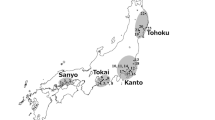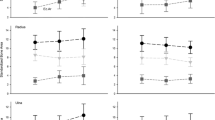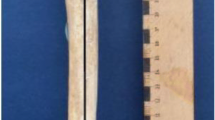Abstract
Cross-sectional properties of long bones are commonly used for reconstructing mechanical loading histories related to locomotion, subsistence strategies, manipulative behavior. In this respect, a significant degree of functional bilateral asymmetry of the proximal arm, likely related to unilateral activity levels, has been reported for Neanderthals.
Previous external analysis of the upper limb bones of the Regourdou 1 adult partial skeleton from Montignac-sur-Vézère, France, showed right side hypertrophy (Vandermeersch and Trinkaus 1995). In order to precise the amount of functional asymmetry and handedness characterizing this individual, we have investigated at 35%, 44%, 50%, and 65% of the shaft length the cross-sectional geometric properties of its humeri by means of synchrotron radiation microtomography (SR-μCT).
Present results support previous conclusion that Regourdou 1 was right-handed. Nonetheless, while a greater strength to compression, flexion, and torsion is shown by the right humerus, only a modest degree of right dominance characterizes this individual with respect to the available Neanderthal figures. Interestingly, the high-resolution three-dimensional-mapping of the humeral cortical bone volume documents a heterogeneous topographic pattern of structural asymmetry along the shaft.
Access provided by Autonomous University of Puebla. Download chapter PDF
Similar content being viewed by others
Keywords
Introduction
Cross-sectional properties of long bone shaft are commonly used in (paleo)anthropology for reconstructing mechanical loading histories and patterns of activity related to locomotion, subsistence strategies, manipulative behaviors (Ruff et al. 1993, 1994; Trinkaus et al. 1994; Churchill and Schmitt 2002; Sládek et al. 2006; Stock 2006).
Available evidence from the fossil record shows that substantial functionally-related structural changes in diaphyseal morphology of the upper limb occurred through the Pleistocene (Ruff et al. 1993). Compared to the condition shown by early anatomically modern humans, the Neanderthal arm is characterized by a degree of robusticity suggesting higher levels of habitual manipulative loads (Trinkaus 1996; Churchill and Schmitt 2002). Likely related to unilateral activity levels and preferences, the humerus also evidences marked bilateral asymmetry, with usual right side hypertrophy (Trinkaus et al. 1994; Trinkaus 2000). In this respect, Neanderthals approximate the pattern of pronounced functional asymmetry currently shown by professional tennis-players (Trinkaus et al. 1994).
Regourdou 1 is a Neanderthal partial skeleton discovered in 1957 at Montignac-sur-Vézère, Dordogne, France (Bonifay and Vandermeersch 1962; Piveteau 1963–1965; Bonifay 1964). This young adult individual of undetermined sex preserves skeletal elements from both upper limbs suitable for accurate morpho-structural comparative analysis and functional interpretation (Vandermeersch and Trinkaus 1995). Nonetheless, while the right humerus is perfectly preserved, the left one is incomplete, lacking the head and consisting of two non-joining diaphyseal portions (the distal one not described by Vandermeersch and Trinkaus 1995).
Previous tomographic (Senut 1985) and radiographic investigation (Trinkaus et al. 1994) of the Regourdou 1 right humerus showed that its structural morphology fits the typical Neanderthal pattern, with marked reduction of the medullary area towards the distal third of the diaphysis. Additionally, the comparative analysis of the external morphology of the right and left upper limb bones revealed diaphyseal asymmetry, with right dominance for most dimensions (Vandermeersch and Trinkaus 1995).
In order to precise the polarity (right vs left side dominance) and the amount of functional asymmetry and handedness characterizing this individual, here we report the results of a high-resolution non-invasive analysis of the endostructural organisation and cross-sectional geometry of its humeri.
Methods
The bi- three-dimensional analyses of the Regourdou 1 humeri are based on a synchrotron radiation microtomographic record (SR-μCT) performed at the beamline ID 17 set at the European Synchrotron Radiation Facility, Grenoble, France (www.esrf.fr/UsersAndScience/Experiments/Imaging/ID17/; experiments SC-1587 and SC-1749).
The ESRF microtomographic system is characterized by continuous energy spectrum, high photon flux, intense monochromatic X-ray beam, nearly parallel projections, and small angular source size. Monoenergetic X-ray beams enable absolute linear attenuation coefficients to be measured and avoid the risk of beam hardening artefacts in the reconstruction of images from dense specimens such as mineralised fossils (Macchiarelli et al. 2006, 2007; Mazurier et al. 2006).
Scans of the two investigated specimens were performed at energy of 51 keV. Projections were taken each 0.35° (1,024/360°). Final sections have been reconstructed from sinograms and saved on a 32 bit floating point raw format at a voxel size of 350 × 350 × 350 μm/pixels. The final 8 bits volumes were elaborated by means of AMIRA v4.0 package (Mercury Computer Systems, Inc.).
On digital cross-sections taken at 35%, 44%, 50%, and 65% of the biomechanical humeral length (Fig. 15.1), the following parameters have been quantitatively measured/calculated: total area (TA, in mm2); cortical area (CA, in mm2); medullary area (MA, in mm2); second moment of area about m-l axis (Ix, in mm4); second moment of area about a–p axis (Iy, in mm4); maximum second moment of area (Imax, in mm4); minimum second moment of area (Imin, in mm4); orientation of greatest bending rigidity (Theta, in degrees); polar second moment of area (J, in mm4); bilateral asymmetry ([(max–min)/min] × 100) of CA, MA, J, Imax/Imin (shape asymmetry) (Trinkaus et al. 1994).
Cortical area measures the amount of compact bone in the diaphysis and relates to the resistance of the shaft to axial loadings. Second moments of area reflect the bending and the torsional strengths of the shaft under loading. The medullary cross-sectional area, which relates to CA, more directly reflects endosteal deposition/resorption patterns. As a whole, these variables measure the geometric contribution of cortical bone to diaphyseal strength (Trinkaus et al. 1994), while the cross-sectional shape of long bone shafts, expressed as ratio Imax/Imin, is used as barometers of activity patterns (Pearson 2001).
Measurements of cross-sectional properties have been performed following Ruff (2002) running NIH Image by means of a Scion Image macro based on established geometric computations (www.hopkinsmedicine.org/FAE/mmacro.htm). Because of its incompleteness, Regourdou 1 left humerus has not been detailed at 50%.
The topographic variation of the cortical thickness between 20% and 80% of the diaphyseal length has been assessed following three-dimensional rendering and mapping. In the case of the right humerus (Fig. 15.2), the cortical volume (CV) has been quantified (in mm3) for the distal and the proximal portions comprised between 35% and 50%, and 50–65%, respectively.
Results
Despite the incompleteness of the left humerus, bone endostructure is very well preserved in both specimens (Fig. 15.3), granting a high reliability of the digital measurements.
For all three comparable sections (35%, 44%, and 65%), the right humerus systematically shows the highest values for all investigated variables. The only exception is represented by the medullary area, which is larger on the left side at 35% (26.1 vs 21.3 mm2; see Fig. 15.3) and at 44% (37 vs 30.3 mm3).
In both humeri, the relatively thickest cortical bone is found distally (35–44%). At 35% of the biomechanical length, cortical bone occupies 90% and 93% of the total cross-sectional area on the left and right specimen, respectively. Similarly, the thinnest bone is found proximally (65%), the difference between the distal and the proximal portions reaching 11.6% on the left humerus.
As assessed on the shaft of a reference young adult humerus (nineteenth century, European origin) detailed by means of the same analytical tool (SR-μCT), the modern human condition is characterized by an absolutely and relatively thinner cortical bone distributed rather homogeneously through the shaft, while both Neanderthal and modern specimens share a topographic distribution pattern of volumetric thickening towards the distal end (Senut 1985; for additional comparative data on Middle and Upper Palaeolithic humans and living urban populations, see Trinkaus and Churchill 1999; Trinkaus 2006).
Percent cortical bone volume (%CV) measured on the Regourdou 1 right humerus for the portion 35–65% equals 83.15%, while a value of 50.45% is obtained for the modern reference specimen.
In Regourdou 1, the diaphyseal section is systematically more circular distally (Imax/Imin). As usually seen in modern humeri, the second moment of area (principal and anatomical axes) and the polar second moment of area (J) decrease distally on both Neanderthal specimens.
With the exception of the medullary area assessed at 35% and 44%, measures of bilateral asymmetry estimated for the variables CA, Imax/Imin, and J indicate right arm dominance in Regourdou 1, being the distal third of the humeral shaft (35%) the least asymmetrical portion (Table 15.1). The most asymmetrical value has been recorded for the polar second moment of area (32.3% at the level of proximal section). Notably, with respect to its counterside, the three-dimensional rendering of the cortical bone topography of the right humerus uniquely evidences a pattern of absolutely thicker bone located on the anterior and posterior aspects of its distal third, likely in relation to the insertion areas of the muscles brachialis and triceps brachii.
Discussion and Conclusions
On both humeri from the Regourdou 1 Neanderthal partial skeleton, the middle-upper shaft (65% to 44%) is characterized by a greater strength to bending in the mediolateral plane (even if the left side is incomplete), while the distal one (44% to 35%) shows a greater bending rigidity in the anteroposterior plane. As a whole, diaphyseal geometric properties of the shafts indicate a greater strength of the right proximal arm to the compressive axial loads, particularly on the distal part, and a greater rigidity to bending and torsion on the proximal portion. Accordingly, present evidence suggests a differential muscular development and mechanical loading pattern for this side, likely related to peculiar and/or more intensive manipulative activities (cf. Schmitt et al. 2003).
The bi-3D elaborations of the high-resolution microtomographic record of the two humeri support previous conclusion that Regourdou 1 was right-handed (Vandermeersch and Trinkaus 1995). Nonetheless, compared to the currently available Neanderthal figures (which are mostly radiographically-based), this individual displays only a modest degree of right dominance, close to the minimum values of the Neanderthal variation range reported so far (for the cortical area measured at 35%, Regourdou 1 shows 9.7% vs 8.4–45.9% for the Neanderthal whole sample; Trinkaus et al. 1994). As suggested by the ongoing high-resolution volumetric analysis of the endostructural morphology of the forearm bones from the same individual (for a preliminary assessment, see Volpato et al. 2005; Volpato 2007), this characteristics of Regourdou 1 may be related to sex variation in Neanderthals (Ben-Itzhak et al. 1988), even it should be noted that the least asymmetric among the Neanderthals is the male Kebara 2 (Trinkaus et al. 1994).
References
Ben-Itzhak, S., Smith, P., & Bloom, R. A. (1988). Radiographic study of the humerus in Neandertals and Homo sapiens. American Journal of Physical Anthropology, 77, 231–242.
Bonifay, E. (1964). La grotte du Régourdou (Montignac, Dordogne) Stratigraphie et industrie lithique moustérienne. L’Anthropologie, 68, 49–64.
Bonifay, E., & Vandermeersch, B. (1962). Dépôts rituels d’ossements d’ours dans le gisement moustérien de Régourdou (Montignac, Dordogne). Comptes Rendus de l’Académie des Sciences, 255D, 1635–1636.
Churchill, S. E., & Schmitt, D. (2002). Biomechanics in palaeoanthropology: Engineering and experimental approaches to the study of behavioural evolution in the genus. In C. S. Harcourt & B. R. Sherwood (Eds.), New perspectives in primates evolution and behaviour (pp. 71–102). Otley: Westbury Academic & Scientific Publishing.
Macchiarelli, R., Bondioli, L., Debénath, A., Mazurier, A., Tournepiche, J.-F., Birch, W., & Dean, C. (2006). How Neanderthal molar teeth grew. Nature, 444, 748–751.
Macchiarelli, R., Mazurier, A., & Volpato, V. (2007). L’apport des nouvelles technologies à l’étude des Néandertaliens. In B. Vandermeersch (Ed.), Les Néandertaliens (pp. 169–179). Paris: Comité des Travaux Historiques et Scientifiques.
Mazurier, A., Volpato, V., & Macchiarelli, R. (2006). Improved non-invasive microstructural analysis of fossil tissues by means of SR-microtomography. Applied Physics A: Materials Science & Processing, 83, 229–233.
Pearson, O. M. (2001). Postcranial remains and the origin of modern humans. Evolutionary Anthropology, 9, 229–247.
Piveteau, J. (1963–1965). La grotte du Régourdou (Dordogne), paléontologie humaine. Annales de Paléontologie (Vertébrés) 49, 285–305; 50, 155–194; 52, 163–194.
Ruff, C. B. (2002). Long bone articular and diaphyseal structure in old world monkeys and apes I: Locomotor effects. American Journal of Physical Anthropology, 119, 305–342.
Ruff, C. B., Trinkaus, E., Walker, A., & Larsen, C. S. (1993). Postcranial robusticity in Homo I: Temporal trends and mechanical interpretation. American Journal of Physical Anthropology, 91, 21–53.
Ruff, C. B., Walker, A., & Trinkaus, E. (1994). Postcranial robusticity in Homo III: Ontogeny. American Journal of Physical Anthropology, 93, 35–54.
Schmitt, D., Churchill, S. E., & Hylander, W. L. (2003). Experimental evidence concerning spear use in Neandertals and early modern humans. Journal of Archaeological Science, 30, 103–114.
Senut, B. (1985). Computerized tomography of a Neanderthal humerus from Le Regourdou (Dordogne, France): Comparisons with modern man. Journal of Human Evolution, 14, 717–723.
Sládek, V., Berner, M., & Sailer, R. (2006). Mobility in central European Late Eneolithic and Early Bronze Age: Femoral cross-sectional geometry. American Journal of Physical Anthropology, 130, 320–332.
Stock, J. T. (2006). Hunter-gatherer postcranial robusticity relative to patterns of mobility, climatic adaptation, and selection for tissue economy. American Journal of Physical Anthropology, 131, 194–204.
Trinkaus, E. (1996). The humerus versus the femur: Changing patterns of diaphyseal robusticity across the late archaic to early modern human transition. L’Anthropologie, 34(3), 239–247.
Trinkaus, E. (2000). The “robusticity transition” revisisted. In C. Stringer, R. N. E. Barton, & C. Finlayson (Eds.), Neanderthals on the Edge (pp. 227–236). Oxford: Oxbow Books.
Trinkaus, E. (2006). The upper limb remains. In E. Trinkaus & J. A. Svoboda (Eds.), Early modern human evolution in Central Europe (pp. 327–372). Oxford: Oxford University press.
Trinkaus, E., & Churchill, S. E. (1999). Diaphyseal cross-sectional geometry of Near Eastern Middle Palaeolithic humans: The humerus. Journal of Archaeological Science, 26, 173–184.
Trinkaus, E., Churchill, S. E., & Ruff, C. B. (1994). Postcranial robusticity in Homo II: Humeral bilateral asymmetry and bone plasticity. American Journal of Physical Anthropology, 93, 1–34.
Vandermeersch, B., & Trinkaus, E. (1995). The postcranial remains of the Regourdou 1 Neandertal: The shoulder and arm remains. Journal of Human Evolution, 28, 439–476.
Volpato, V. (2007). Morphogenèse des propriétés texturales du tissu osseux et environnement biomécanique. Caractérisation non invasive du réseau trabéculaire et de l’os cortical du squelette appendiculaire de Mammifères actuels et fossiles, Hominidés inclus. Ph.D. dissertation, University of Poitiers, France.
Volpato, V., Couture, C., Vandermeersch, B., & Macchiarelli, R. (2005). Cortical structural geometry of the Regourdou 1 Neandertal upper limb: Bilateral asymmetry and handedness. Bulletins et Mémoires de la Société d’Anthropologie de Paris, 17, 288–289.
Acknowledgments
Research developed within the EC TNT project (http://www.the-neanderthal-tools.org) in collaboration with the Musée d’Art et d’Archéologie du Périgord (Périgueux, France) and the European Synchrotron Radiation Facility (ESRF, Grenoble, France), supported by the French CNRS, the GDR 2152, the Région Poitou-Charentes. Special thanks to A. Bergeret, L. Bondioli, A. Bravin, F. Couturas, G. Marchesseau, V. Merlin-Anglade, A. Mazurier, C. Nemoz, C. Ruff, P. Tafforeau, G.-C. Weniger.
Author information
Authors and Affiliations
Corresponding author
Editor information
Editors and Affiliations
Rights and permissions
Copyright information
© 2011 Springer Science+Business Media B.V.
About this chapter
Cite this chapter
Volpato, V., Couture, C., Macchiarelli, R., Vandermeersch, B. (2011). Endostructural Characterisation of the Regourdou 1 Neanderthal Proximal Arm: Bilateral Asymmetry and Handedness. In: Condemi, S., Weniger, GC. (eds) Continuity and Discontinuity in the Peopling of Europe. Vertebrate Paleobiology and Paleoanthropology. Springer, Dordrecht. https://doi.org/10.1007/978-94-007-0492-3_15
Download citation
DOI: https://doi.org/10.1007/978-94-007-0492-3_15
Published:
Publisher Name: Springer, Dordrecht
Print ISBN: 978-94-007-0491-6
Online ISBN: 978-94-007-0492-3
eBook Packages: Earth and Environmental ScienceEarth and Environmental Science (R0)







